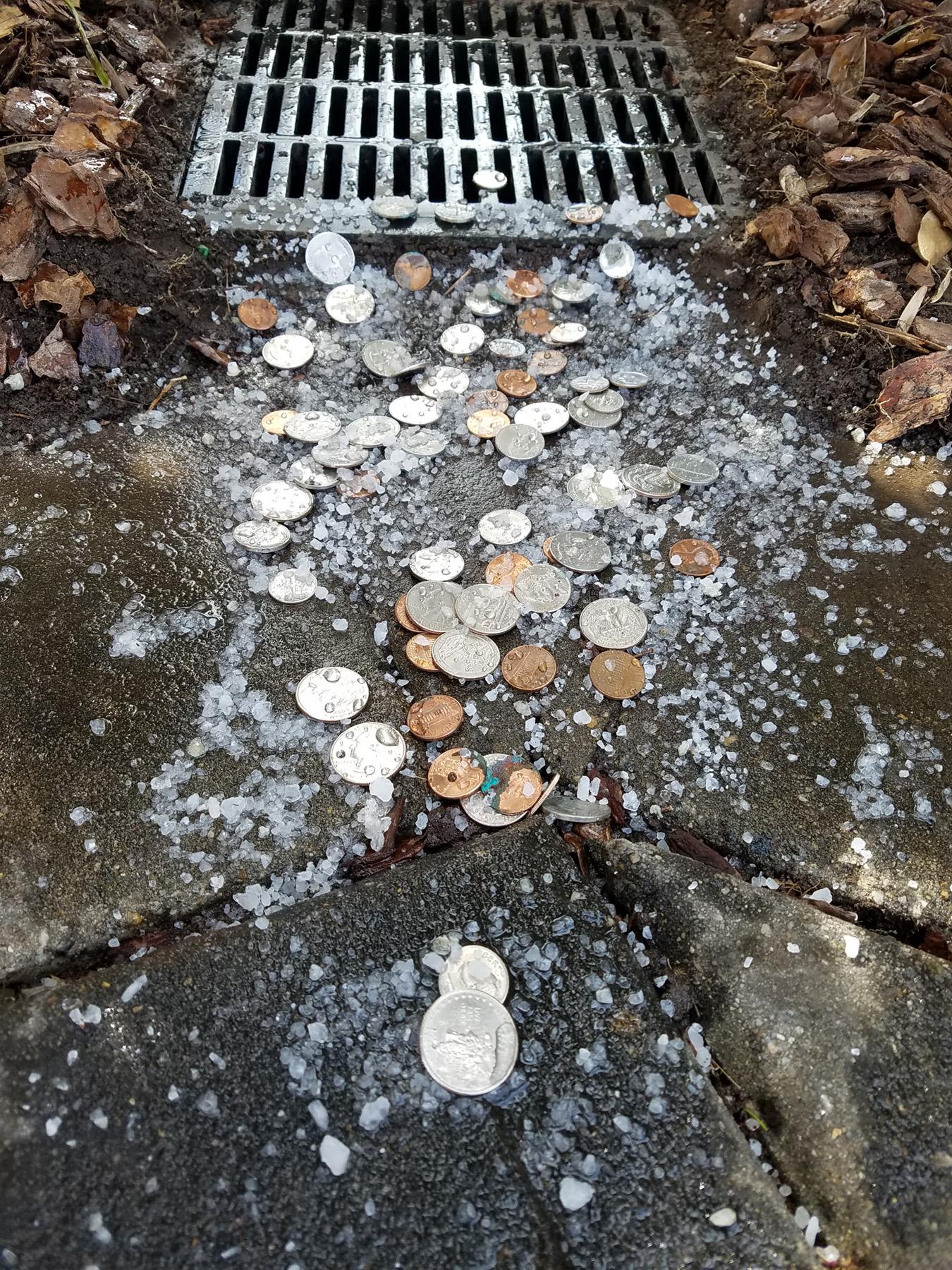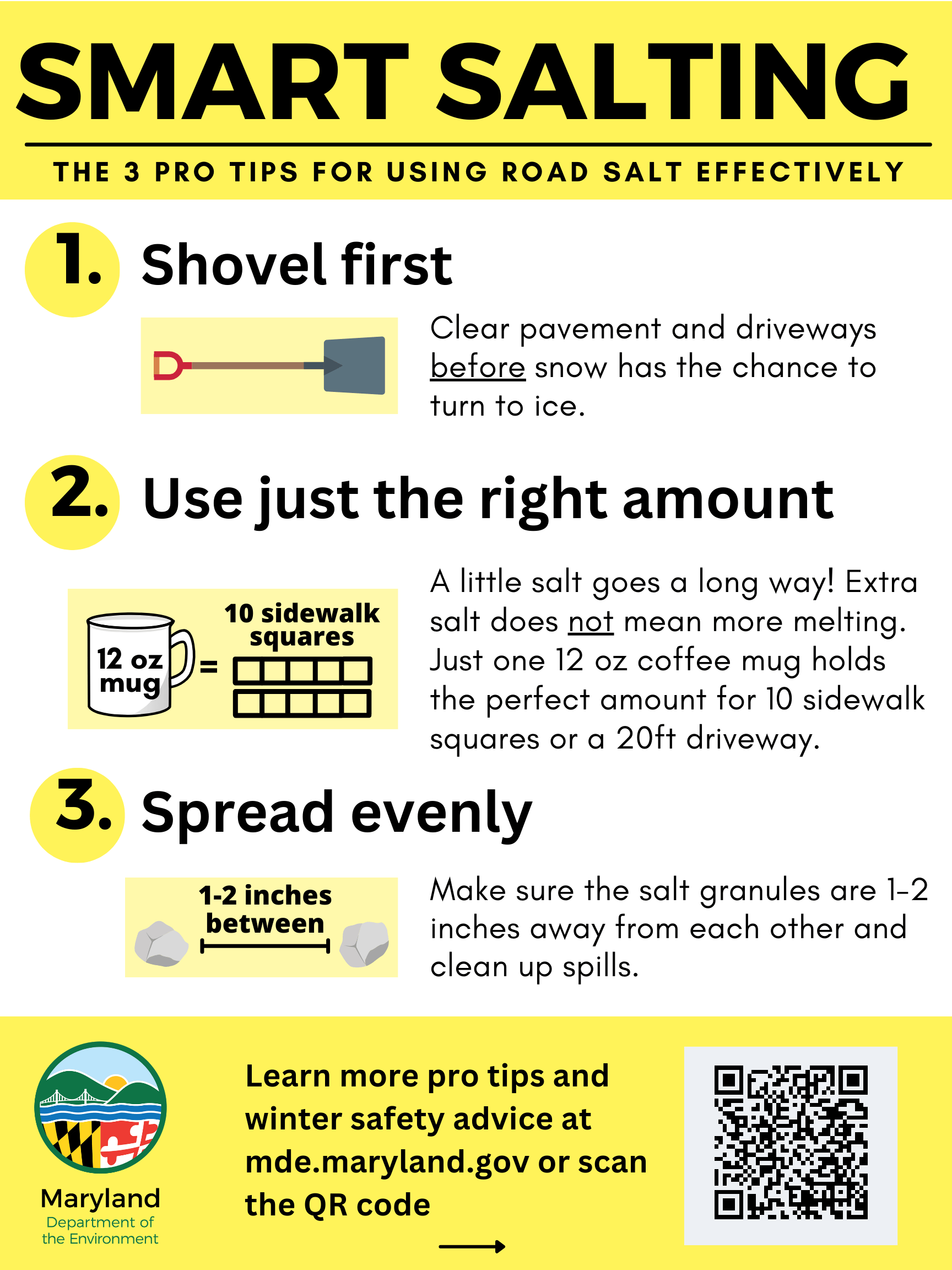
EBR-2023-0666 | August 2024
Being Salt Smart

Using winter salt to provide safe roads, parking lots, and sidewalks during ice or snowstorms is common in Maryland, with the vast majority used on roads. However, many times too much winter salt is used during these winter storms. Many people think salt is there to melt snow or ice and tend to follow the “more is better” philosophy, but that’s not salt’s primary job. Oversalting doesn’t really help, which means it’s literally throwing money down the drain!
Salt’s job is to act as a barrier between ice or snow and the surface it lands on to make shoveling or plowing easier, so it’s best to use it before a storm or just after you’ve finished shoveling. Salt has virtually no effect after the snow has started to accumulate.
The overuse of salt in Maryland affects our drinking water and is accumulating in groundwater. It can be harmful to pets, hurts our streams, and leads to corrosion of infrastructure like pipes, roads, sidewalks, and bridges.
Once it’s applied, salt is very difficult to remove from the environment, so the best way to keep it out of our streams and groundwater, which serves as our drinking water, is to not use it. Unfortunately, we know that we can’t just flip a switch and turn off all salt applications in the state, so the best solution is to learn how salt smarter.
As homeowners, we can play a role in reducing salt use in our neighborhoods and keeping our state’s waters healthy while protecting people from slips and falls on our properties. Here are several options to manage snow and ice in your community without having to use salt:
- Shovel early, Shovel well, and Shovel again. Manually removing snow and ice is always the most environmentally friendly. Be sure you are physically able to shovel.
- Cover small critical areas like steps with a tarp before a storm. Be sure to secure it with weights if the storm will have high winds. The tarp can be removed after the storm for ice free steps.
- Talk to your Homeowner’s Association about the issue. Hiring trained professionals can help keep local sidewalks and roads safe with less salt. The Maryland Department of the Environment (MDE) has developed a training and certification program for winter maintenance professionals. https://mde.maryland.gov/programs/water/319NonPointSource/Pages/saltapplicators.aspx
If you do need to use salt, then there several smart salting tips that you can follow to make sure you use the right amount for the right reason:
- A little goes a long way. A 12 oz. mug of salt is enough for 10 sidewalk squares.
- Avoid clumping and spread evenly. Salt granules should be at least 1-2 inches apart.
- Salt before a storm, or after you’ve cleared snow and ice.
- Sweep and reuse salt if a storm doesn’t happen (it can be reused later if you keep it dry).
Remember, winter salt’s primary job is to make shoveling and plowing easier, not to melt existing snow or ice. Work with us to reduce the amount of winter salt applied in our communities during winter storms while keeping you and others safe.
To learn more about salt and its impacts, visit the Maryland Department of the Environment’s “Winter Salts” webpage: https://mde.maryland.gov/programs/water/319NonPointSource/Pages/411-on-Salt.aspx

ANDY LAZUR
State Water Quality Specialist Water Quality
lazur@umd.edu
http://extension.umd.edu/programs/environment-natural-resources/program-areas/wells-septic-systems-and-water-quality/
GREG SANDI
Chief, Watershed Restoration Planning Division Maryland Department of the Environment
gregorio.sandi@maryland.gov
https://mde.maryland.gov/programs/water/319NonPointSource/Pages/411-on-Salt.aspx
This publication, Being Salt Smart (EBR-2023-0666), is a part of a collection produced by the University of Maryland Extension within the College of Agriculture and Natural Resources.
The information presented has met UME peer-review standards, including internal and external technical review. For help accessing this or any UME publication contact: itaccessibility@umd.edu
For more information on this and other topics, visit the University of Maryland Extension website at extension.umd.edu
University programs, activities, and facilities are available to all without regard to race, color, sex, gender identity or expression, sexual orientation, marital status, age, national origin, political affiliation, physical or mental disability, religion, protected veteran status, genetic information, personal appearance, or any other legally protected class.
When citing this publication, please use the suggested format below:
Lazur, A., & Sandi, G. (2024). Being Salt Smart (EBR-2023-0666). University of
Maryland Extension. go.umd.edu/EBR-2023-0666